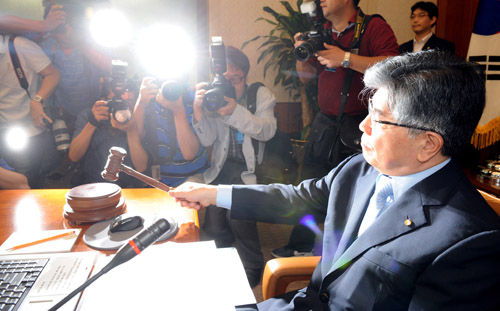What’s the interest in interest rates?

After a long stretch - 17 months - of a record low key rate of 2 percent, the Bank of Korea last month raised interest rates and is expected to do so again this year. [JoongAng Ilbo]
Recently other countries around the Asia-Pacific, including Australia and Malaysia, have raised their borrowing rates.
All eyes will return to the central bank later this month to watch its next move on interest rates because there are rumors that it will once again push the rate up in the second half of this year.
Every month the Bank of Korea holds a Monetary Policy Committee to decide whether to change the key rate.

The key rate is one of the most important monetary policy tools used by the central bank. It is the standard used in setting a wide range of interest rates that stretches from yields on CDs and treasury bonds as well as loan interests and deposit interests.
Basically it is the lowest rate that the central bank applies when trading with financial companies, including commercial banks, whether lending or retrieving national funds.
The central bank will control liquidity in the market by selling and buying bonds from financial institutions.
In times of economic difficulties, like the one Korea suffered through since the late 2008 meltdown of the global financial system, the government lowers the nation’s base rate. But when the economy is in a growth path, like the one we are enjoying today, the government raises the rate in order to keep the lid on inflationary pressure due to the excessive currency flows.
So what effect will a low key rate have on the economy?
As the world economy tumbled after the financial meltdown in the U.S. in late 2008, Korea gradually lowered the key rate until it hit a historic low of 2 percent in September 2009 and has kept it at that level until last month.
The biggest reason the BOK has kept the rate at 2 percent was to boost the nation’s economy.
By buying bonds from financial companies, the BOK released money into the market and boosted liquidity in the financial sector.
Additionally, once the key rate is lowered, other financial companies lower their rates.
This means that consumers, including households and private companies, will be less attracted to the low interest return on deposits.
And with excessive capital in the financial companies and low interest on loans, households and companies will be tempted to borrow money, which boost the spending and investment that powers the economy. That is why stock markets are more active in time of low interest rates, because people can earn much on deposits in banks and prefer to buy stocks.
But lowering the key rate doesn’t necessarily create an economic boost.
When the credit situation of households or companies are shaky, they won’t borrow even when liquidity is pumped into the system, and that liquidity just circulates within the financial markets. This is called a “liquidity trap” and that’s what actually happened during the early stage of our recent financial crisis.
Then, in times of economic expansion, the central government raises the key rate to cool down an overheated market which can raises inflationary pressure by raising the value of assets such as real estate.
Inflation is a danger to an economy because the price of goods, particularly basic products needed in daily life such as food and milk, shoots up.
In order to stabilize consumer prices the central bank has to reduce the currency flow. This is done by BOK selling bonds back into the market. That way, excessive liquidity is absorbed back into the central bank. Money becomes scarce and value goes up.
Moreover, excessive spending or investments later turns into a massive current account deficit that can strain the overall economy.
The BOK has kept the key rate at its record low even though there was mounting evidence that Korea’s economy was on a stable, recovered path.
But inflation wasn’t out of control: consumer prices, even until last month, hadn’t risen above the government’s maximum of 4 percent, and Korea’s real estates value are flat or declining because investors are iffy about the market.
The government and the central bank’s target are different. The government’s goal is continued expansion of the economy whereas the central bank is focused on stabilizing consumer prices. Therefore the government advocates lower interest rates to keep a heavy flow of money into the market.
Additionally when the key rate is higher it becomes more difficult for the government to create funding, including loans, to keep the economy rolling.
That is why at the beginning of the 2008 crisis, the government wanted lower rates so it could finance its projects to keep the economy afloat.
The BOK raised the key rate to 2.25 percent last month as it expects the nation’s economy to enter an expansion phase, which will raise consumer prices.
The consumer price, although has been moving within the BOK target range, has been showing disturbing signs.
Last month consumer prices grew 2.6 percent from a year earlier, which showed stability. However, prices on fresh goods such as garlic and cabbages shot up 16.1 percent from a year earlier. This was the largest growth in six years.
With such a trend, there is a strong possibility that the central bank could raise the key rate once again this year, perhaps as soon as this month.
By Lee Ho-jeong [ojlee82@joongang.co.kr]










with the Korea JoongAng Daily
To write comments, please log in to one of the accounts.
Standards Board Policy (0/250자)